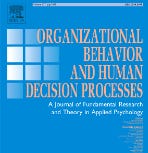New articles in OBHDP (July 25th, 2024)
Range goals as dual reference points
https://www.sciencedirect.com/science/article/abs/pii/S0749597824000323
Scott Wallace, Jordan Etkin
Goal setting is ubiquitous. People set goals for how much weight to lose before summer, how many steps to take in a day, and how much money to set aside for a special vacation. The literature on goal setting has largely focused on specific goals, emphasizing their benefits relative to “do your best” goals. The authors propose that an important alternative—range goals—has largely been overlooked. A range goal for saving money, for example, might be $1200–$1500 dollars. Across 5 main studies (and 6 supplemental studies), the authors found that goal pursuers’ outcomes tended to cluster around the endpoints of their goal range (e.g., exactly $1200 or exactly $1500), rather than being normally distributed along the goal range. Importantly, their work found that, in some situations, range goals led to higher performance than specific goals. Whereas prior work has conveyed range goals as a “moderately vague”—and, therefore, less effective—approach to goal-setting, this work indicates that range goals helpfully provide multiple salient reference points that goal pursuers can flexibly target as they pursue their goal.
Cultural tightness in organizations: Investigating the impact of formal and informal cultural tightness on employee creativity
https://www.sciencedirect.com/science/article/abs/pii/S074959782400030X
Roy Chua, Na Zhao, Meng Han
Creativity has long been regarded as a critical component of organizations’ competitiveness. Consequently, organizations are invested in enhancing employees’ creative performance. One way to encourage creativity is through the organization’s culture. The authors explore how creativity is affected by cultural tightness—the strength of social norms and the degree of sanctioning in a given community. This work distinguishes between formal and informal cultural tightness. Formal cultural tightness involves norms enacted through official structures, clearly outlining the organization’s expectations to ensure operational effectiveness. In contrast, informal cultural tightness derives from unwritten social norms and collective beliefs about appropriate behaviors. Across a field study with 14 companies and two experiments, the authors found that informal cultural tightness tends to stifle employee creativity.
P.S. if you can’t access the full-text let us (m-kouchaki@kellogg.northwestern.edu or mikebaer@asu.edu) know and we’d be happy to share a copy.


